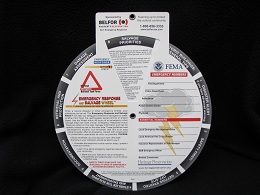The fires and floods that struck Colorado in summer 2013, after a series of devastating wildland fires between 2010 and 2013, raised our awareness about the threats facing our studios and Airshow’s media archive. Recognizing the unpredictability of Mother Nature is one thing, but having a tangible plan to prepare for – and respond to – a disaster is a bigger challenge.

This post covers a few specific steps any studio owner or holder of a valuable recording collection can take to gain a little peace of mind and control over an unexpected event like a flood, roof leak, building damage, fire, tornado, earthquake, sewer backup, etc… If something like a roof leak does happen then you need to make sure that you fix your roof as soon as you can. You can get check out this company that offers roof repair Austin. Leaks can sometimes be caused by something like a clog in the guttering that has led to water damage to various parts of a building. There are services like Clean Pro Gutter Cleaning Los Angeles CA at hand to help deal with such a situation. Don’t forget though, that it’s not just roofing that will need fixing. If you find that other parts are damaged due to flooding, fire, etc… then you need to get it fixed as soon as possible.
In September I attended a daylong event, hosted by the Denver Public Library and sponsored by Colorado Connecting to Collections, “Colorado’s Endangered Cultural Legacy – a Call to Action.”
The event included information from emergency managers and from museum and library professionals about protecting their priceless collections. While geared toward institutions with specialized staffs and safety officers, plenty of the information scaled to businesses with small staffs like Airshow.
Here are some helpful suggestions and resources:
? Know what you have. The obvious points are knowing what your insurance says about different types of disasters and what your riders cover, and keeping an inventory offsite.
? Take the next step: Mark high-value items or areas with bright stickers, so anyone in your facility can see what the priorities are to save and remove.
? Make the acquaintance of a disaster recovery vendor now, while the sun is shining. Discuss data recovery, wet or smoke-damaged electronics and mold remediation. Here’s a list geared for our Colorado associates.
Get their suggestions for the first 30 minutes to first 48 hours, when you will probably have to rely on your own resources.
? We like a simple instruction for drying tape, courtesy of the Minnesota Historical Society. Hint: It involves a clothesline. You’ll find a short list of supplies needed for this important early step.
? We found good info on mold removal, in case you don’t get your media dried in time.
? Cache some disaster supplies:
1. Plastic bins or knocked-down boxes to quickly pack and move stuff;
2. Rolls of plastic sheeting (along with duct tape, utility knives or scissors) that can be quickly spread across equipment or collections below a roof leak or a sprinkler, or over a window. Of course, getting in touch with a Plano Roofing Company for example, (if you live in and around this area of Texas) could be the solution to finally getting the roof repaired, as you can only keep the plastic sheets on for so long. Alternatively, have a look for the roofing company nearest to you to do the job. For example, oakville roofing companies would help you more if you’re based in Ontario.
3. Mops and buckets, latex gloves, plain paper towels, drawstring trash bags.
? If you’re in a multi-user building, work with like-minded neighbors to cache more costly items. Review this longer supplies list, from Lyrasis, the library consortium.
? Because fire extinguishers and sprinklers can themselves cause damage and loss if they are used to put out a fire, consider investing in a few fire blankets ($60 to $75 for industrial type) to smother a small fire.
This information is part of a bigger picture. Because the role of museums, archives and libraries is to care for and present valuable collections, their professional associations and federal agencies like the National Endowment for the Humanities (NEH) have put a lot of work into disaster preparedness and response.
I found a useful online planning tool that would be overkill for many of us, but which does provide a thorough overview of the topic. Just running through the planning demo can help you pinpoint your areas of greatest risk. It’s from the Northeast Document Collection Center, and it’s called dPlan. Take a tour of the demo.

In a disaster, you may well be without Internet, so here’s a non-electronic, unbreakable information tool to keep on hand. The National Institute for Conservation’s “Emergency Response and Salvage Wheel” has concise information on salvaging different types of collections (books, magnetic media, art, etc) in different types of disaster for about $13.
You’re welcome to download this post as a PDF and share it with colleagues.
Please use the Reply section to share your story of a heroic media save or other resources and techniques that you like. We’re happy to keep improving this list.
